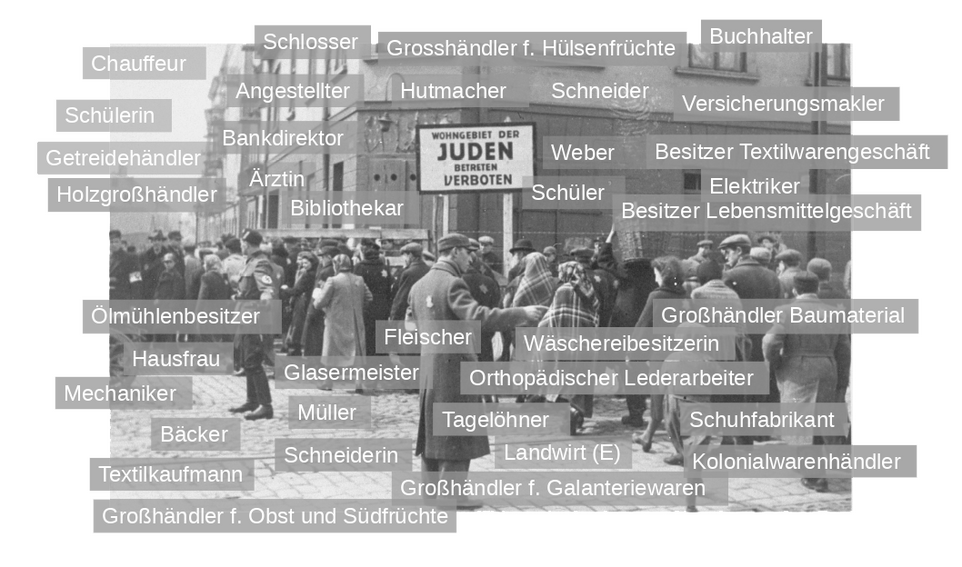Introduction
Thanks to the affidavits (about 450) and the supplementary information such as answers to questions and records with data from earlier trials, it is possible - as already mentioned - to get a very good picture of the situation of the Jewish victims of persecution before, during and after the persecution. Among other things, the documents mention
- Origin, occupation and age of applicants
- Ghettos
- labor camps
- Work to be performed
- Periods and places of imprisonment
- fate of persecution
Origin, occupations, age of the persecuted persons
The countries of origin were taken from the files. According to this, the vast majority of applicants came from Poland, followed by German, Czech, Lithuanian, Hungarian, Romanian, Ukrainian, Latvian and Slovakian applicants:
- Poland: 894 applicants
- Germany: 91 applicants
- CSR: 61 applicants
- Lithuania: 51 applicants
- Hungary: 41 applicants
- Romania: 35 applicants
- USSR: 8 applicants
- Latvia: 7 applicants
- Ukraine: 3 applicants
- Slovakia: 2 applicants
Occupations
Before the war, they were craftsmen (butchers, locksmiths, tailors, mechanics, shoemakers, bakers, painters, hairdressers, glaziers, carpenters, weavers, etc.), farmers, employees, traders and merchants (livestock, wine, grain, textiles, wood, building materials, clocks, etc.), entrepreneurs (wood processing, oil factories, spirit factories, liqueur production), academics (doctors) or came from such families.
Age Distribution
The age distribution, in so far as it was possible to determine the year of birth:
- 1880-1889: 15 applicants
- 1890-1899: 62 applicants
- 1900-1909: 152 applicants
- 1910-1919: 338 applicants
- 1920-1929: 480 applicants
- 1930-1939: 114 applicants
Fate of applicants
The following fates of the applicants can be found in the files:
- 623 were in ghettos/camps/labour camps during the entire period of persecution
- 193 were able to escape from ghettos and subsequently lived in hiding in so-called "illegality"
- 314 applicants fled to or were expelled to the USSR in 1939 ("Russian cases")
- 63 emigrated or were forced to emigrate
- The fate of 308 applicants could not be determined
Ghettos
List of Ghettos mentioned
Baranowicze, Bedzin, Berehovo, Bershad, Biala-Podlaska, Bialystok, Borszczow, Boryslaw, Brody, Brzesko, Brzeziny, Budapest, Budzyn, Chelm, Chrzanow, Chust, Czernowitz, Czortkow, Deblin, Debrecen, Diatlovo, Dombrowa, Dombrowica, Drobin, Dywin, Dzialoszyce, Edinetz, Ghetto, Glebokie, Grodno, Grosswardein, Holszany, Hrubieszow, Isa, Izbica, Jagielnica, Janow, Jaslo, Kamionka, Kaunas, Kielce, Klausenburg, Kleszczele, Kolomea, Komarow, Konskie, Krakau, Lemberg, Lodz, Lokacze, Lublin, Luck, Lucka, Ludwipol, Lukow,Majdan-Tatarski, Mako, Makov, Mielec, Munkacs, Nagykaroly, Nagy-Szöllös, Nove, Opole, Oshmyany, Pabianice, Parczew, Pinsk, Piotrkow-Trybunalski, Plonsk, Podbrozie, Podhajce, Pruzana, Przemyslany, Radom, Rakow, Rejowiec, Riga, Rokitno, Ryki, Rzeszow, Sambor, Sandomierz, Sanok, Sarnaki, Sarny, Satora-Ujhely, Satu-Mare, Schaulen, Shanghai, Slonim, Smorgon, Sosnowitz, Stanislawow, Starachowice, Stoczek, Stopnica, Stryj, Swir, Szalard, Szarvas, Szatmar, Szeklencze, Targu-Mures, Tarnogrod, Tarnopol, Tarnow, Tiacevo, Tlumacz, Tluste, Trembowla, Trzebinia, Tschenstochau, Tyszowce, Uzhorod, Warschau, Wilna, Wladimir-Wolynsk, Wlodowa, Wolbrom, Zamosc, Zbarazh, Zdzieciol, Zelechow, Zwolen
Forced labour camps and concentration camps
List of concentration camps and forced labour camps-labourcamps
The following concentration camps, subcamps and forced labour camps were mentioned by the applicants:
Allach, Annaberg, Altenburg, Ansbach, Auenrode, Aurich-Engerhafe, Auschwitz, Auschwitz- Althammer (englisch), Auschwitz-Bobrek, Auschwitz-Günthergrube, Auschwitz-Monowitz, Auschwitz-Jaworzno, Berlin-Haselhorst , Bergen-Belsen, Blechhammer, Blizyn, Bolkenhain, Bor, Boryslaw, Brande, Braunschweig, Bremen-Hindenburgkaserne, Bremen-Obernheide, Brünnlitz, Buchenwald, Bunzlau, Burgau, Bisingen, Chemnitz, Christianstadt (Krzystkowice), Dachau, Dautmergen, Dęblin, Dörnhau (Dornau), Dukla, Ebensee, Elsnig, Ereda, Falkenberg, Fallersleben, Faulbrück, Flöha (Flöhen), Flossenbürg, Freiberg, Freiwaldau, Friedland, Fürstenstein, Gabersdorf, Geisenheim , Geislingen, Georgenthal, Geppersdorf, Gleiwitz, Gogolin, Golleschau, Görlitz, Groß-Rosen, Groß Sarne, Grünberg, Gundelsdorf, Gunskirchen, Hailfingen, Hamburg-Langenhorn (Ochsenzoll), Hamburg-Poppenbüttel (Sasel), Hamburg-Steinwerder, Hannover-Mühlenberg, Helmbrechts, Helmstedt-Beendorf, Hersbruck, Hildesheim, Hindenburg, Hohenstein, Janikowo, Kaiserwald, Kaltwasser, Kassel, Kaufering, Kaunas-Aleksotas, Kielce-Henrykow (Hendrikow), Kivioli, Klein-Mangersdorf, Klettendorf, Kodliczewo/Kolditschewo, Koschedaren, Königs Wusterhausen, Kaunas, Krosno, Krychow, Lachowitz, Landeshut, Landsberg, Landshut, Langenbielau, Langenstein-Zwieberge, Laura, Laurahütte, Leipzig-Schönau, Leipzig-Schönefeld, Leitmeritz, Lemberg-Janowska, Lisowce, Ludwigsdorf, Ludwigslust , Lübecker Bucht (Cap Arcona), Märzbachtal, Magdeburg, Majdanek, Markstädt, Mauthausen, Mehltheuer, Melk, Metzdorf, Mielec, Mittelbau-Dora, Modrzejow, Mühldorf, Neuengamme, Neusalz, Niederorschel, Nowe Miasto, Nürnberg, Ober Altstadt, Ohrdruf, Oranienburg, Ostrowiec, Ottmuth, Parschnitz, Peterswaldau, Plaszow, Plonsk, Prokocim, Pustkow, Rainsdorf, Rakow, Ravensbrück, Reichenbach, Rozanowka, Rzeszow, Sachsenhausem, Salzwedel, Sakrau, Schachendorf, Schömberg, Schlieben, Seibersdorf, Sigmar-Schönau, Skarzysko-Kamienna, Sophienwalde, Stalowa Wola, St. Georgenthal, St. Valentin, Stolp, Stutthof, Theresienstadt, Thorn, Trzebinia, Tröglitz, Tschenstochau, Türkheim, Uelzen, Vaihingen, Vaivara, Viivikonna, Waldenburg, Warschau, Watenstedt, Wesserling, Wielicka, Wiesau, Wilischthal, Wolanow, Wüstegiersdorf, Zagorze, Zwittau
Descriptions of the camps can be found at:
- deutschland-ein-denkmal.de
- Gedenkstättenportal zu Orten der Erinnerung in Europa
- Haftstättenverzeichnis on the website of the Federal Archives
and, of course, on the webpages of memorial sites.
